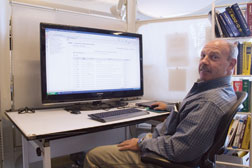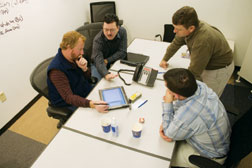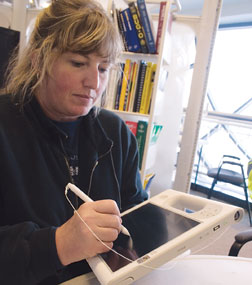...leasing companies might say it voided their warranty. The leasing companies agreed to do it,” Perry says.
There have been no warranty issues, says Scott Tierney, a Cianbro construction and equipment manager. The job ran B100 all summer in every engine on the site, including 1970s-era cranes, pile drivers, excavation equipment and generators.
“I haven’t had one bit of a problem,” says Ken Cloyd, director of pile driving. With a few filter changes in the beginning, biodiesel runs cleaner and removes all of the soot buildup inside the engine.
 Tom Sawyer / ENR Scott Tierney is a Constructware power user with one of the 47-in. displays.
|
“I think its great,” adds Hugh Moseley, an 11-year truck-driving veteran in charge of Destiny’s biofuel logistics. “It smells better and won’t give you a headache, and we don’t have to go anywhere and kill for it.”
Excavation contractor A.P. Reale used a Leica GPS system, with a base station for blade control. “They say it saved them a great deal of time,” says Russ Wiederspahn, Destiny’s technology project coordinator. It also keyed in locations for “a ton of underground utilities,” Wiederspahn says. “The electricity is dead, but some of the water and sewer is live.”
Cianbro’s one-person survey crew, John Quinn, uses the same base station and $50,000 worth of Topcon GPS survey equipment to control placement of 140-ft to 350-ft H14 x 117 piles in 1,133 locations. “This is the perfect job to do this. There are so many piles, and it is all open no tall buildings or trees,” Quinn said in November as he marked locations for the piles as the pile-driver banged away, sinking 140 ft lengths in an average of 10 minutes each. “I love it, absolutely love it. This would have taken so long otherwise,” Quinn said.
Equipment manager Scott Tierney says, by the end of November, the job was using a 50% biofuel mix. There is testing of additives, but none were in use. Heating blankets were being procured for some of the equipment engines, especially the cranes, in an attempt to return to B100. “I know the equipment manufacturers can help us overcome the gelling problem with the fuel. It’s just a matter of time before they make that happen,” Vigue says.
Paper’s End
Paper documents are literally disappearing. “We had a house elf go around and collect all the drawings and recycle them,” says Watson. In the fourth-floor project office that surrounds the existing mall’s atrium, drawings are replaced by whiteboards, wall-panel displays and 47-in. desktop monitors presenting models of geometry, schedule and cost.
 Tom Sawyer / ENR Visiting Cianbro managers get a briefing on Destiny technology implementation.
|
The large displays are also used to coordinate the Autodesk Revit-based architectural model, with contributions from other modeling software used for structural engineering, HVAC, plumbing, fire suppression and electrical systems. NavisWorks is used for clash detection, and Constructware is used for construction communications and document management. Both NavisWorks and Constructware are relatively recent Autodesk acquisitions.
“This is the electronic version of coordination drawings,” Watson says. “We run clash detection every two weeks and had 4,000 clashes the first time. You fix those, and when you are done, you have a perfect project. It actually is the buildable model, but you’ve got to build it where it shows in the model.”
On the jobsite, paper is being replaced by pen-sensitive tablet PCs in various models sold by Motion Computing. They are running electronic forms and document management systems that now are being tested and customized. The portable computers—20 so far—are issued to Destiny, Cianbro and key sub personnel who are charged with collecting data on the site. They include safety inspectors, supervisors and quality-assurance and quality-control monitors.
 Tom Sawyer / ENR Bridget Reid, Cianbro safety engineer, can log reports with photos in the field on Compaq Model tc4400.
|
“The people in the field are extremely receptive,” Vigue says. “It’s working very, very well. We are trying several devices to identify the ideal ones that complement a construction environment.” He describes as a “breakthrough” the discovery of a handheld device designed to work in a medical environment “where they had to constantly disinfect the devices, which means they had to get wet and be scrubbed vigorously.” One area where the technology implementation team is having difficulties is finding devices to blanket the site with a fast, robust, highly reliable wireless network, he notes.
Vigue says the field team so far is pleased with the portable electronic tools it has been given to use, but he is wary of how well they will perform in the winter’s cold. “A lot of these screens don’t operate well in freezing temperatures,” he notes. Consequently, the technology crew is working on creating a heated kiosk for use as a mobile, climate-controlled, self-powered “electronic gang box” in the field.
Vigue says it is very important not to deploy tools that fail. “If we give them a device that doesn’t work, then we lose credibility. Every time we take a step forward, it has got to be the right step, it has to operate, and it has to make their job easier.”
The key here is not to give up, keep searching, keep looking and work with the manufacturers. Nobody said it was going to be easy, but it is important. So we are doing it,” Vigue says. “We are having success with it and improving the process almost daily,” he says. “That is significant progress.

Post a comment to this article
Report Abusive Comment